This article is a collection of short reflections made by some of the junior leaders and private soldiers of Charlie Company (C Coy), 1st Battalion Royal Australian Regiment following their deployment to Malaysia as Rifle Company Butterworth (RCB), rotation 121. It has been put together to highlight the lessons learned and observations made whilst working alongside the Malaysian Armed Forces (MAF) during the annual bilateral exercise, EX HARINGGAROO 69.
Though based on the specific, and somewhat idiosyncratic, interactions between C Coy soldiers and those of the the Malay Battalion they partnered, the lessons are applicable, in varying degrees, to any future international engagement exercises that may be conducted within the South East Asia region. They also apply to future RCBs where there will be a requirement to work with other MAF units and organisations.
Security Force Capacity Building Lessons Learned from Malaysia Charlie Company: First Battalion, The Royal Australian Regiment
Introduction
This article is a collection of short reflections made by the soldiers and officers of Charlie Company (C COY), 1 RAR, following their deployment to Malaysia as Rifle Company Butterworth, rotation 121 (RCB 121). It has been put together to highlight the lessons learned and observations made whilst working alongside the Malaysian Armed Forces (MAF) during the annual bilateral exercise, EX HARINGGAROO 69. The overall theme explored in this article is the concept of ‘Partnering’. That is, operating in a bilateral environment where both forces intimately integrate and work under a unified command structure to achieve the same mission.
Charlie Company came under tactical command (TACOMD) of the 1st Battalion, Border Regiment (1RS) during EX HARINGGAROO 69; thus, it was required to intimately integrate and build seamless relationships across all ranks and functional groups. This integration was necessary to generate a successfully partnered organisation. Integration was achieved through a variety of structural changes including attachment of a 1RS platoon into C COY, and detachment of a C COY platoon into a Malaysian Company. Additionally, integration was achieved through both structured and informal combined activities including cross training, sports competition and social functions.
The ability to effectively establish relationships and accept the different planning and tactical processes greatly aided in C COY’s partnering efforts. As such, the reflections made by the soldiers and officers of C COY highlight shared experiences in relationship building considering the various cultural, tactical and organisational differences and similarities and how they aided or diminished successful partnering.
Though this article is based on the specific and somewhat idiosyncratic interactions between C COY soldiers and those of 1RS, the lessons identified through these reflections are assessed to be applicable, in varying degrees, to any future international engagement exercises that may be conducted within the South East Asia region. The lessons identified also apply to future RCBs where there will be a requirement to work with other MAF units and organisations.
Building Trust Prior to C COY’s deployment into the field as part of EX HARINGGAROO 69, its soldiers spent a week integrating with the soldiers of 1 RS through, training, parading, dining and combined sports activities. We may not have realised it at the time; however, this was perhaps one of the most important parts of EX HARINGGAROO 69. It allowed each nation’s soldiers to begin building trust in one another. A personal learning point was the realisation that sometimes we need to remove ourselves from our own ‘comfort zone’, immerse ourselves in the culture, and just participate. An example of this is the late night karaoke sessions that the Malaysians would request we participate in following dinner each night.
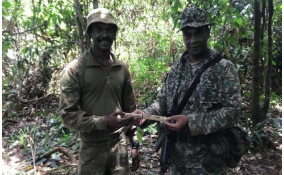
Though this initially seemed like an odd nightly activity, it became apparent that despite how awkward we felt, our participation was highly regarded. Our involvement allowed us to build rapport and trust – something simple that went a long way. Another aspect that allowed the Australians to earn the trust and respect of the 1 RS team was through the soldiers’ enthusiasm to learn the basics of Bahasa Melayu (Malaysian language) and actively practice it. Again, this may seem simple; however it should not be understated. Through short interactions at the local café, on the drill square or, during physical training, it became very evident that the members of 1RS truly appreciated the small efforts that we were showing in trying to adopt parts of their culture. This was mutually beneficial for soldiers as well, as it tested them intellectually and facilitated their ability to buy goods and services with locals.
Finally, I also found great value in the exchange of gifts and tokens of appreciation. Although there was a formal exchange of gifts by the Headquarters, it was the informal and small gestures that had the greatest value in building trust. Simple things such as the exchanging unit patches, shirts, or in one instance the presentation of a carved wooden dagger representing C COY, handed to a Malaysian soldier. The effects of these small actions aided in our immediate success throughout the remainder of the exercise and I am sure greatly assisted in the maintenance and enhancement of the partnership between the MAF and Australian Army.
Lieutenant Luke Hughes
Partner Hospitality
My best experience from EX HARINGGAROO 69 came from the hospitality shown by the Malaysian soldiers of 1RS. I have worked with international forces prior to this, in a number of different settings and this is the most welcome I have felt by far. At the start of the exercise we conducted a few physical training sessions with the MAF soldiers. During these, the soldiers of 1 RS appeared overjoyed to participate in the sessions with us. They demonstrated a desire to work together during paired exercises and communicate through movement to bypass the obvious language barrier.
At the formal functions, the soldiers and officers were always enthusiastic and rarely needed encouragement to engage with us and even sing some karaoke together, events to which we were happy to participate in.
In addition to the arranged activities, we played sport with the 1 RS soldiers, in combined teams where we mixed the teams in order to strengthen camaraderie, mateship and foster trust amongst the two forces.
If I can take anything away from this experience, it is how much it means for a partner force to feel welcomed and involved when they are hosted in a foreign country. The warm reception by the Malaysians made us instinctively reciprocate in kind. Soldiers would always be enthusiastic to participate in cross training or socialise with the Malaysians, learning about tactics and culture alike. This welcoming hospitality aided in our effective integration into the 1RS team, building trust and a foundation on which we could train as a cohesive team. Corporal John Mitchell
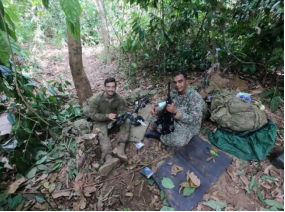 Shared Values
Shared Values
A lesson that I personally learnt from working with the Malaysian Army is that, even though we speak different languages, we share many of the same values. An example I observed was through Malaysian Signaler that was attached to our platoon for the duration of the field exercise. This soldier spoke very little English and our Malaysian wasn’t much better. Despite this he would sit with us in our weapons pits, sharing jokes and talking tactics – no matter how long it took to get the content of the conversation across. If we were cleaning our weapons, he would come and clean his weapon with us, or we would share a coffee and have a chat.
This highlighted to me that soldiers from around the world, just like us, are interested in getting to know their counter parts. We all enjoyed working with an allied force and seeing the similarities and differences; and when it came down to it, we all learnt a lot by just sitting down, sharing a brew and having a chat.
Lance Corporal Charles Stuart
Cultural Considerations
When planning, it is important to consider the cultural requirements of the soldiers with whom you are exercising. As identified during EX HARINGGAROO 69, during planning we had not considered the requirement for the Islamic soldiers to pray often throughout the day. In addition to considering the need to allocate time for this, we had not considered the tactical considerations and requirements it posed on the other soldiers during these periods. As a commander, I developed a higher level of appreciation for the planning requirements in a bilateral environment, where there is a necessity to demonstrate cultural understanding, compassion and patience. It is not good enough for us to simply expect everyone else to exercise in accordance with our values, beliefs and practices.
I had to adapt my planning and my approach to the tactical task, in order to appropriately consider the cultural requirements of my new team. I adjusted mission timings to allow greater flexibility and provided security to enable the 1RS soldier’s freedom to exercise their spiritual needs. These considerations may sound simple; however, are often forgotten, misunderstood or ill-considered. Coming to a reasonable compromise that shows respect to cultural customs whilst still achieving our own mission can be tricky, particularly with the language barrier. Lieutenant Luke Hughes
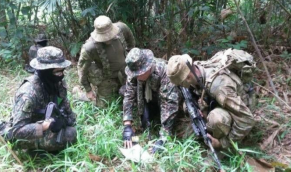
Physical Training and Sports
I observed that the MAF is a very professional, enthusiastic and a well-motivated organisation which emphasises the necessity for physical training and sports. During EX HARINGGAROO 69, Australian and Malaysian soldiers were able to attend multiple combined physical training sessions and sporting events which directly aided in the development of a cohesive working environment between the two teams.
During physical training, warm-ups consisted of various partner orientated exercises such as fireman lift and carry, wheelbarrow races, and sprints as a group. There was also a lot of yelling, particularly counting in unison and calling catch words. This built teamwork and esprit de corps, something I imagine is similar to the U.S. Marines ‘Oorah’.
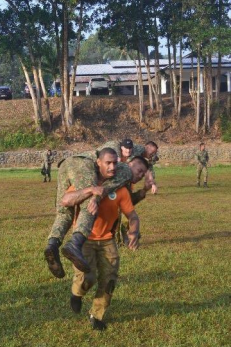
The Malaysians also held ‘Sportos’ every afternoon where they played a variety of sports. One of the easiest and most popular sports was Futsal – played in a five-a-side style cage match with both teams being a mix of MAF and Australian Army. This team layout forced soldiers from both forces to work together and integrate at the lowest level – whilst demonstrating the Malaysian dominance at the sport! This acted as a bit of an ice breaker and allowed the banter to flow between both sides. It also broke down the language barrier as spectators on both sides understood what was happening, as opposed to simply conducting structured physical training where at times both forces were too fatigued to integrate.
Sepak takraw or kick volleyball is a sport native to South East Asia and very popular with the Malaysian soldiers. It is essentially a three a side hackey-sack played similarly to volleyball over a net. Most Australians were awful at this game which made having a Malaysian soldier on your side incredibly valuable. Not only could they try and explain the rules, they generally dominated the game by themselves, whilst the Australians just served or collected the ball when it went out. As useless as we were, it did create a chance for us to have a laugh with the Malaysians and marvel at their acrobatics.
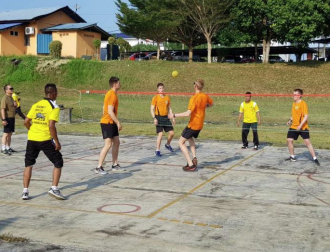
As simple as it may be, playing sport is a great tool to break the ice and build a much stronger partnership with your counterparts. Whilst it may not be the main training objective, it should be included in all international engagement activities. For many soldiers, the interactions had and the experiences gained from these sporting activities are ones that many soldiers will not forget.
PTE Jason Pegnall and PTE Edward Ferrier
Contrasting Capabilities
During the field training component of EX HARINGGAROO 69 we learnt a great deal from the MAF elements embedded within C COY. Of note was the direct fire capability of the 1 RS platoons, highlighted by their weapons and the immense volume of fire they could generate by comparison. This overmatch and tactical advantage naturally lent them to being positioned on likely enemy approaches when static and in depth for manoeuvre when patrolling.
The soldiers of 1RS employed different sustainment methods to the Australians, enabling a unique ‘fight light’ approach’. Of note was their reliance on sourcing water locally, thereby only requiring to carry one to two litres on the person for any period. This approach reduced the burden on the sustainment chain and increased patrol flexibility as it could now move into areas the Australians could not. Whilst this had it benefits, it would also provide challenges. As the burden of resupply from a headquarters was reduced, the patrolling and night locations were restricted to locations in close proximity to fresh water sources.
As soldiers and officers of C COY we pride ourselves on our ability to effectively operate at night. Through employment of Enhanced Night Fighting Equipment (eNFE), we have a marked improvement in our dismounted combatant’s capability and lethality compared to conventional forces from other nations. Unfortunately for us, there was an element of friction when it came to exploiting our enemies’ weakness through the conduct of night operations, as our partners lacked any comparable capability. It would take detailed analysis and planning to execute tasks effectively by night while still including our Malaysian counterparts. However, having developed a good relationship prior to commencing the field component of the exercise, we had a good understanding of each other’s capabilities, and procedures and as such were able to develop hybrids procedures that supported joint night operations. This coupled with effective orders and joint rehearsals allowed us to effectively fight at night despite our vast differences in capability.
Ultimately, our success at fighting alongside the Malaysians lay in our intimate understanding of each other’s capabilities and limitations, and then being able to compromise and adapt the way we do business. Rather than fight as two separate entities, we would attempt to multiply our capabilities as our combined capability was greater than our own. Having developed good relationships with our partners allowed us to have frank and open discussion about what we could and couldn’t do without fear of offending each other, or one trying to appear superior to the other. This was critical in allowing us to successfully adapt to each other’s requirements as we could share our ideas honestly and without pretence.
Lieutenant Simon Thompson
Sharing Ideas
Militaries all over the world conduct similar tactical actions with similar sequence of events to conduct tasks. While these holistically remain the same in terms of considerations, not all of their tactics, techniques and procedures are identical. This is why blending the partnered forces’ procedures through discussion, analysis and rehearsal is so important.
During EX HARINGGAROO 69, C COY made an extensive effort to share its procedures with 1RS to ensure that there was a common understanding and appreciation of the way we operate, in addition to an understanding of our capabilities. This was facilitated through briefs and demonstrations where both nations participated. These demonstrations also served as joint rehearsals between the two forces. This took the form of “we’ll show you how we do it, and then you show me how you do it”, which was followed-up with discussion between soldiers and commanders. This allowed commanders to identify the different strengths and vulnerabilities of each force and thus developed an understanding of how each force would be best employed.
This single action of partnering allowed for all tactical commanders to understand what both partner forces would look like on the ground if given certain tasks, it also smoothed any friction points and developed trust in both organisations abilities to conduct tasks.
Lieutenant Dylan Conway
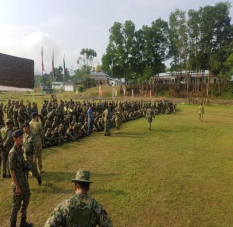
Conclusion
EX HARINGARROO 69 proved an invaluable experience in partnering for the soldiers and officers of C COY. They embraced the intimate integration into 1RS and as such were able to seamlessly operate with their Malaysian partners in both the barracks and field environment. Though there were some vast differences in culture, tactics, techniques and procedures, the friction that was created by these differences was easily overcome as both C COY and 1RS were able to adapt and learn.
This adaptation was only successful because of the concerted effort that was placed on developing effective and positive relationships between the Australian and Malaysian soldiers at all levels – relationships characterised by trust and respect. Furthermore, the success of the exercise was also hinged on a thorough understanding of each other’s capabilities and limitations, as we openly demonstrated and discussed what we could and couldn’t do; having an acceptance and respect for each other’s abilities and then working together to generate joint capability
The original article is available.









